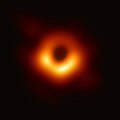Properties
Astronomers believe that supermassive black holes (SMBHs) can be ejected from the centers of galaxies by gravitational wave recoil. This happens when two SMBHs in a binary system coalesce, after losing energy in the form of gravitational waves. Because the gravitational waves are not emitted isotropically, some momentum is imparted to the coalescing black holes, and they feel a recoil, or "kick," at the moment of coalescence. Computer simulations suggest that the kick can be as large as 104 km/s, [1] which exceeds escape velocity from the centres of even the most massive galaxies. [2]
Stars that are orbiting around the SMBH at the moment of the kick will be dragged along with the SMBH, providing their orbital velocity exceeds the kick velocity Vk. This is what determines the size of the HCSS: its radius is roughly the radius of the orbit that has the same velocity around the SMBH as the kick velocity, or
where M is the mass of the SMBH and G the gravitational constant. The size R works out to be roughly one-half parsec (pc) (two light-years) for a kick of 1000 km/s and a SMBH mass of 100 million solar masses. The largest HCSSs would have sizes of about 20 pc, roughly the same as a large globular cluster, and the smallest would be about a thousandth of a parsec across, smaller than any known star cluster. [3]
The number of stars that remain bound to the SMBH after the kick depends both on Vk, and on how densely the stars were clustered about the SMBH before the kick. A number of arguments suggest that the total stellar mass would be roughly 0.1% of the mass of the SMBH or less. [3] The biggest HCSSs would carry perhaps a few million stars, making them comparable in luminosity to a globular cluster or ultra-compact dwarf galaxy.
Aside from being very compact, the main difference between an HCSS and an ordinary star cluster is the much greater mass of the HCSS, due to the SMBH at its centre. The SMBH itself is dark and undetectable, but its gravity causes the stars to move at much higher velocities than in an ordinary star cluster. Normal star clusters have internal velocities of a few kilometers per second, while in an HCSS, essentially all the stars are moving faster than Vk, i.e. hundreds or thousands of kilometers per second.
If the kick velocity is less than the escape velocity from the galaxy, the SMBH will fall back toward the galaxy nucleus, oscillating many times through the galaxy before finally coming to rest. [4] In this case, the HCSS would only exist as a distinct object for a relatively short time, of order hundreds of millions of years, before disappearing back into the galaxy nucleus. During this time the HCSS would be difficult to detect since it would be superposed on or behind the galaxy.
Even if an HCSS escapes from its host galaxy, it will remain bound to the group or cluster that contains the galaxy, since the escape velocity from a cluster of galaxies is much larger than that from a single galaxy. When observed, the HCSS will be moving more slowly than Vk, since it will have climbed out through the gravitational potential well of the galaxy and/or cluster.
The stars in an HCSS would be similar to the types of stars that are observed in galactic nuclei. This would make the stars in an HCSS more metal-rich and younger than the stars in a typical globular cluster. [3]

